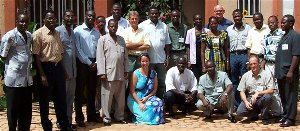|
||||
Strengthening Dryland Decisions with ScienceDMP members learn to use decision support tools (DSTs)Improved technologies for managing crops and farms are complex and interactive. Different nutrients applied to soils break down at different rates and produce different results with different crops and crop varieties. Crops themselves have differing effects on soils and on each other in crop rotation sequences. Livestock are vital to dryland livelihoods; their manure as well as income generated from their sales have a large influence on family welfare, and the resources available to farmers for sustainable land management. To make things even more complex, all these interactions differ across locations, for example in comparing the drylands of the Sahel with the wetter areas of Africa's equatorial zone. Scientists and extension specialists need help to analyze this
complexity and deliver the right recommendations to dryland farmers.
Computer-based 'decision support tools' (DSTs) help them analyze
what will happen when one crop or management practice is
changed for another under their conditions. Training in DSTs enables DMP
members to make good use of the enormous amount of knowledge and
experience that is captured in models of agro-ecosystem behavior. The workshopTowards this end, a training workshop on 'Use of Decision Support
Tools in Sahelian Agriculture' was held at the Centre d’Accueil de
Conférences et de Séminaires (CACS) in Ouagadougou, Burkina Faso
from 21 to 25 June 2004. It was co-organized by the International
Center for Soil Fertility & Agricultural Development (IFDC),
the Desert Margins Program,
and the Institut du Sahel (INSAH/CILSS).
Twenty researchers participated. Eleven were sponsored by the Desert
Margin Program, 8 by INSAH and 1 by IFDC. Participants were trained to use three DSTs: SIMFIS (Simulating
Mixed Farming Systems in the Sahel),
NUTMON (Nutrient Monitoring),
and QUEFTS (Quantitative Evaluation of the Fertility of Tropical
Soils). The workshop was facilitated by Dr. Tjark Struif Bontkes
and Mr.
Kofikuma Dzotsi. What participants did—and will doParticipants learned to use the DSTs on real problems facing their home countries. A follow-up workshop in June 2005 will evaluate the outcomes of these case studies. IFDC will assist the participants as they apply these DSTs, ensuring that results are ready for presentation and discussion at the 2005 workshop. More about the DSTsThe NUTMON toolbox focuses on soil fertility. It can be used to evaluate and improve nutrient balances on individual farms. It consists of a questionnaire, a background database, a data entry module and a data processing module—creating an inventory, monitoring and analyzing nutrient flows and economic performance at the farm level. SIMFIS simulates crop-livestock interactions. (Livestock are an especially important part of Sahelian agricultural systems). It can identify causes of poor performance of crop-livestock systems; suggest sustainable solutions; and estimate the impacts that different alternatives might have on long-term sustainability. QUEFTS is a static crop growth model. It helps determine the best soil fertility management options to optimize both plant nutrition and economic returns on investment. RIDEV is a dynamic rice growth model that can guide irrigated rice growers in the Sahel, especially in choosing the best date to sow the crop, the best rice variety to plant, and the timing of nitrogen fertilizer applications. CropSyst is a dynamic crop growth simulator modeling the relationships between weather, soil, crop and management. It models crop development, water and nitrogen balances, effects of salinity, the fate of chemical residues, soil erosion by water, the effects of crop rotation, irrigation and nitrogen fertilization, and the management of crop residues. |
||||
|

